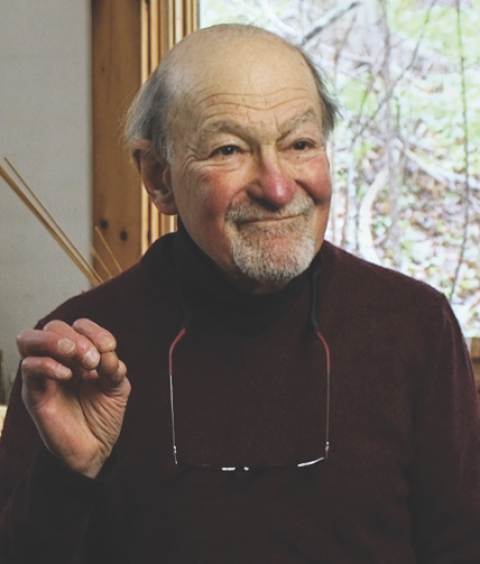Columbia College | Columbia University in the City of New York
Edward Koren ’57, Cartoonist Who Poked Gentle Fun at American Society

JÖRG MEYER
Koren credited Columbia’s humor magazine, Jester, for launching him on his career path; he began contributing in his first year at the College and as a senior became editor-in-chief.
He published his first New Yorker cartoon in 1962; it depicted a struggling writer in a “Shakespeare” sweatshirt, puzzling over his typewriter. With Charles Addams, James Thurber and Saul Steinberg, Koren was one of the most popular artists in The New Yorker’s long love affair with cartooning. His long-nosed, hairy, pen-and-ink characters — sometimes of indeterminate species — were instantly recognizable.
“My trajectory was a comedy of manners,” Koren said in a 2018 interview for his New York Times obituary. “I was drawn to sociology and cultural anthropology. My work was a bit tame, I suppose. I avoided sex. It was political in a different sense. I examined the middle class, and everywhere I looked people were outraged. I did not want to manifest that in my work. I just gravitated toward animals.”
Koren created some 1,100 cartoons for The New Yorker, including dozens of covers, and many more for The Nation, Time, Newsweek, The New York Times, Vogue, Vanity Fair and other publications. He also published several cartoon collections, wrote and illustrated children’s books, and illustrated books by other authors, including Delia Ephron, George Plimpton and Alan Katz. In total, he illustrated 25 books and wrote nine.
His artwork appeared in shows and galleries across the United States as well as in England, France and Czechoslovakia; many pieces became part of museums’ permanent collections. He also made cartoons for commercial clients, including vineyards, banks, university course catalogs and credit cards. In 2010, The Miriam and Ira D. Wallach Art Gallery hosted the retrospective Edward Koren: The Capricious Line.
Calling his work “profoundly” autobiographical, Koren said he got his ideas by leaving the house and observing the world around him, jotting down quick sketches in a notebook. “I’m the kind of American middle-class folk I like to draw,” he told the Knight-Ridder news service in 1982. He found inspiration everywhere. Walking in the woods in California, he was passed by a runner, who called out, “Working on my quads!”
“There’s a cartoon,” Koren said.
The Times noted that Koren usually tried to express something positive in a bad situation. For a post 9-11 New Yorker cover, he drew “The Best Offense,” which featured a mouselike creature holding up a long nib pen in its right paw and a short sword, point down, in its left.
“There’s an immense sweetness to his personality that radiates through his work,” David Remnick, the editor of The New Yorker, said after Koren’s death. “This was not an acerbic comic spirit. He had a very different sensibility. There was a real soulfulness to everything he did.”
Edward Benjamin Koren was born in New York City on December 13, 1935, the only child of Harry and Elizabeth (née Sorkin) Koren. He was raised in Mount Vernon, N.Y., from which his father commuted to a dental practice in Manhattan. His parents wanted him to become a doctor or lawyer, but once he began drawing as a teenager he was hooked.
After graduating from Horace Mann School in the Bronx and then the College, Koren studied printmaking, etching and engraving for two years with painter S.W. Hayter at the prestigious Atelier 17 in Paris, and earned an M.F.A. in 1964 from Pratt. He soon joined the faculty of Brown University, where he taught the arts until 1977, leaving to become a full-time freelance artist.
After vacationing in Vermont for years, Koren became a full-time resident in 1982. He joined the volunteer fire department (and was a captain for 30 years) and rode a bicycle nearly every day; he called it “an addiction.”
Koren never retired. He was presented a Doctor of Humane Letters degree from Union College, a John Simon Guggenheim Fellowship in Fine Arts and the Vermont Governor’s Award for Excellence in the Arts, and was appointed Vermont’s second Cartoonist Laureate, a position he held 2014–17. For The New Yorker’s April 17, 2023, issue, he drew Moses on a mount overlooking his people and holding up a stone tablet of the Ten Commandments in Roman numerals while proclaiming, “Time for an update!”
Koren married Miriam Siegmeister in 1961. They had two children, Nathaniel and Alexandra, who goes by Sasha, and were divorced in 1973. He married Catherine Curtis Ingham, who goes by Curtis, in 1982 and they had a son, Benjamin. Koren is survived by his wife; children; and two grandchildren.
— Lisa Palladino
Issue Contents
Published three times a year by Columbia College for alumni, students, faculty, parents and friends.
Columbia Alumni Center
622 W. 113th St., MC 4530, 6th Fl.
New York, NY 10025
212-851-7852
cct@columbia.edu
Columbia Alumni Center
622 W. 113th St., MC 4530, 4th Fl.
New York, NY 10025
212-851-7488
ccalumni@columbia.edu

